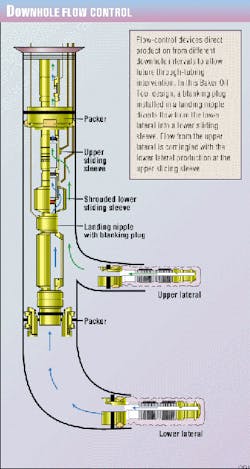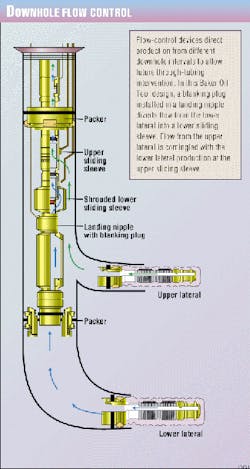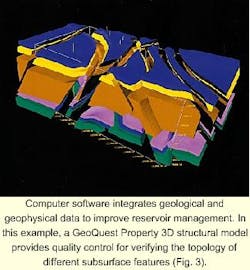In the past decade, oil and gas producers have implemented a variety of new technologies for accelerating production, lowering costs, and extracting hydrocarbons from accumulations that previously were technologically or economically inaccessible.
This accelerated pace of change during the 1990s is bound to continue into the new millennium as industry takes full advantage of previously developed technologies and adds improved, more cost-effective methods for recovering sufficient hydrocarbons to meet projected increased demand.
The past decade has seem major advances in technology dealing with:
- Horizontal and multilateral-well production.
- Artificial lift options for producing wells.
- Coiled tubing for well workovers, well completions, and flow lines.
- Intelligent or smart completions.
- Field automation and communications for better remote operations.
- Multiphase flow, pumping, and measuring.
- Production facilities and well completions placed in ever-deeper water.
- 3D seismic, time-lapsed seismic (4D), and visualization for pinpointing remaining recoverable reserves.
- New technology and regulations concerning production by-products, such the large amounts of produced water co-produced with oil.
- More-effective products and methods for stimulating and treating wells.
- New logging tools that expand the understanding of reservoirs.
But challenges remain, such as:
- Improving recovery efficiencies-significant hydrocarbons are still left behind even after implementing waterflooding and enhanced oil recovery processes.
- Expanding reservoir characterization techniques for delineating heterogeneities.
- Controlling water production to reduce costs and prevent pollution.
- Recovering the large known accumulations of heavy oil (see related article)
- Finding better, more cost-effective methods for dealing with paraffin, asphaltenes, various scales, hydrates, and water production.
- Recovering oil and gas from low-permeability reservoirs.
- Designing production technology for deepwater production (see related article).
Complex completions
Downhole production systems have become more complex as industry completes subsea wells in deeper water and drills wells with horizontal, multilateral, or "designer" trajectories. One technology being introduced for these wells is referred to as "intelligent" or "smart" completions systems.
Systems currently being developed are primarily for high-producing, deepwater subsea completions. In general, the systems integrate downhole pressure, temperature, and flow sensors with remotely operated, fully adjustable downhole chokes for flow control. Multiple flow-control devices, addressed independently, provide zonal control and monitoring.
This technology aims to:
- Reduce or eliminate costly subsea-well interventions, such as with wireline or coiled tubing.
- Provide selective, remote control of production from individual zones and downhole water and gas injection into other zones.
- Optimize comingled production and injection.
- Prevent zonal crossflow in multilateral and horizontal wells.
- Improve reservoir knowledge and management capability.
Fiber-optic temperature sensors are one new technology being included in some complex extended-reach wells, such as in the BP Amoco PLC-operated Wytch Farm in the UK In one Wytch Farm application, fiber optics were run to monitor temperature, on a continuous basis, in a well that is both an oil producer and water injector.
In the Wytch Farm well, the use of fiber optics allows temperature measurements every 1 m, with the entire acquisition process taking about 15 min. Recordings have been made with the well flowing, both with and without water injection, and during shut-in as the temperature begins to return to the geothermal gradient.
Temperatures obtained along the producing interval have correlated with zones expected to flow and also have confirmed water production and cross flow into other zones behind an unperforated section of casing, where water fingering had been suspected.
Fiber optics for continuous temperature measurement is also starting to be run in steamflood wells. Estimates are that about 100 such installations have been made.
Another type of intelligent downhole completion being tested involves microrobotic technology with artificial intelligence. These robots, parked downhole, are activated from the surface when needed. After moving and accomplishing its task, the robot returns to its parking space to await new orders.
Future completions may also eliminate large surface facilities by processing crude downhole. Combined with downhole oil-water separators and pumps, these downhole separators would eliminate moving large volumes of unwanted fluid to the surface. Only processed crude would reach the surface.
These concepts are in various stages of testing but, according to some projections, may find applications in the next decade of the new millennium.
Artificial lift
Artificial lift will become even more important in the next millennium as reservoir energy continues to decline in most of the world's large oil fields, and as water production increases in many of these fields.
Even today, most oil wells produce with artificial lift. Also, artificial lift serves in such applications as dewatering coalbed methane wells and unloading water from gas wells.
One artificial lift equipment manufacturer estimates that 80% of the world's producing oil wells require some form of artificial lift. In North America, this is almost 90%.
Sucker rod, beam-pumped wells are the most common and undoubtedly will remain the dominate artificial lift method for sometime to come in the new millennium. One current estimate is that, within the US, more than 400,000 wells produce with beam pumps.
A major change seen with beam-pumped wells is the addition of new diagnostic, real-time software and sensors that allow operators to better understand pump loads as well as fluid dynamics, so that pump operations become more efficient with less maintenance cost.
The other four principal types of artificial lift-progressive cavity pumps (PCPs), electrical submersible pumps (ESPs), hyraulic lift (jet or piston), and gas lift-have also benefited from the new diagnostic software.
One trend in artificial lift is the combination of various technologies. PCP pumps have been introduced that are driven with downhole motors instead of a rotating sucker rod string. These ESPCPs are primarily designed for applications in highly deviated or horizontal wells.
Combining gas lift with ESPs or rod pumps have been reported to help improve pumping efficiency in fields in Colombia and India. Installations have also been proposed to combine ESPs and jet pumps (ESJPs) to handle gassy fluid with conventional ESP technology.
Hydraulic pumps, such as those installed in the North Sea's Captain field, rely on a turbine drive, which allows high running speeds, and variable speed operations while eliminating all downhole electrical equipment.
ESPs have been deployed with coiled tubing, eliminating the need for workover rigs for running and retrieving pumps. The electric cable can be strapped to the outside of the tubing or be inside it.
Stimulating wells
New treating chemicals and methods continue to enter the market as the understanding of reservoir rock and fluids improves through the use of new diagnostic tools that can more precisely define their character.
As an example, in the past, X-ray analysis could not generally distinguish among specific types of feldspar. Today, however, powder diffraction X-ray equipment can produce digitized spectra analyses that determine the kind of feldspar present, thus improving the understanding of what type of treatments will be compatible with the formation.
With this increased understanding, stimulating wells with either acids or hydraulic fracturing (fracing) is more likely to lead to increased production. Acidizing has primarily been used in carbonates and cleaning near the wellbore but with more understanding of the reservoir, sandstone acidizing may become more effective. Fracing has traditionally been used in tighter sand formations, although the past decade has seen the benefits of fracing high-permeability zones (frac-packs). One of the recent trends in hydraulic fracturing is to reduce polymer loading to minimize conductivity damage.
Multiphase fluid handling
Handling a multiphase fluid-rather than separating fluids near the wellhead and handling each fluid in a separate flow line-is becoming an alternative in production-gathering lines.
Although avoided in the past, large-scale, dual liquid and gas-gathering lines have become more practical because advanced surface facility simulation allows engineers to better predict multiphase flow in a single gathering line, as illustrated by Texaco Exploration & Production's redesigned gathering system for its Aneth Unit miscible carbon dioxide flood.
Multiphase pumps are another technology that is gaining wider use. These pumps handle multiphase fluid that needs a pressure boost to flow from the well to a centralized production facility.
These pumps are being installed to:
- Reduce back pressure on oil and gas wells, thereby increasing producing rates.
- Boost pressure between an oil and gas field and central processing facility.
- Boost pressure at a gas processing facility where liquids are present.
Multiphase pumps or boosters have been installed in both onshore and offshore environments. One estimate is that about 150 units from six or seven manufacturers have been installed. Of these, over 70% are twin-screw pumps, 20% are progressive cavity (PC) pumps, and the other 10% are helico-axial (H-A) pumps.
The H-A is a high-volume flow, centrifugal pump that develops pressure dynamically. It can be highly sensitive to variations in density and therefore has found most of its applications on subsea wellheads, which tend to have higher flow rates with less density variations.
The twin-screw and PC pumps are positive displacement pumps that are primarily used onshore.
Another technology making multiphase flow more practical is the advent of various types of multiphase metering systems. These meters are starting to replace conventional test separators, in both onshore and offshore applications.
With a conventional test separator, individual components of flow (oil, water, and gas) have to be separated before each flow can be measured separately.
Multiphase meters allow measuring fluids without having to first separate out each component. The meters are designed to obtain a velocity measurement as well as phase-fraction measurement. From these values, the meter calculates a flow volume. Different manufacturers use different technologies.
The following are techniques for obtaining velocity: mixing and differential pressure, positive displacement, cross-correlation, and cross correlation combined with differential pressure.
For phase-fraction measurement, the meters can include: microwave attenuation, gamma-energy absorption, dielectric properties.
Multiphase meters can be used for both continuous in-line testing as well as a temporary installation.
Handling by-products
Water is the largest waste stream associated with oil and gas production. It costs significant amounts of money to produce, treat, and discard or use.
Reuse of the water eliminates its pollution potential. Reuse can include reinjection water for pressure maintenance, irrigation water for agriculture if the water is relatively fresh, and feed water for steam generators in steam floods.
One new technology being developed is downhole oil-water separators. A number of these are being tested. By separating out water downhole, water can be reinjected downhole without having to bring it to surface, thus eliminating treatment and disposal costs. Simultaneous production and injection has the added benefit of minimizing the opportunity for contaminating underground sources of drinking water, through leaks in tubing and casing during the injection process
In one study, half of the installations in North America covered by the study showed increased oil production after installation of downhole separators.
The two basic downhole separators designs are: hydrocyclones and gravity separation. Hydrocyclone separators have been paired with electric submersible pumps, rod pumps, and PC pumps. Gravity-type separators have used only rod pumps.
Even though individual components of downhole oil-water separators have been tested, the challenge is to build separators and pumps that work together in a confined space in a bottomhole environment.
The technology holds tremendous promise for the next millennium but more work is still needed.
Although water is still the primary by-product of crude that needs to be dealt with, there are other components that may become issues in the future. Some hazardous constituents in crude include n-hexane, benzene, toluene, ethylbenzene, xylenes, polycyclic aromatic hydrocarbons, hydrogen sulfide, vanadium, and nickel compounds.
For gas, one of the techniques of eliminating co-produced acid gas (gas with CO2 and/or H2S) is reinjection into disposal wells. Although not practical for many situations, a number of Canadian operators have found it to be an effective solution.
Coalbed methane
Coalbed methane (CBM) is an other energy resource with significant potential for the next millennium. The wells tend to be shallow and are low cost to drill and complete. But the production rates per well also tend to be relatively low, with many wells producing less than 100 Mscfd.
During the last decade, CBM activity decreased in the US because of the expiration of a tax credit for coalbed methane. But, as more understanding of coalbed gas has been attained, activity again has picked up in such places as the Powder River basin in Wyoming and the Raton basin in New Mexico.
In some instances, water production with coalbed methane can be high, but because this water tends to be relatively fresh, states such as Wyoming allow it to be discharged into ponds and drainages, greatly improving production economics.
Coalbed methane recovery can be enhanced by injecting gases such as nitrogen and carbon dioxide.
Burlington Resources Inc. is conducting the world's first, long-term production pilot for carbon dioxide-enhanced coalbed methane recovery carbon dioxide (CO2-ECBM) in the San Juan basin, in New Mexico.
Nitrogen-flood ECBM, which depends largely on creating methane partial-pressure differentials in the reservoir, has been tested by BP Amoco, also in the San Juan basin. Theoretically, 1 Mcf of nitrogen can displace an equal volume of methane, although initial tests have been reported to have experienced early breakthrough of nitrogen.
Process control software
New software and sensors are providing operators a means to control process equipment to prevent excessive production downtime. The technology removes the guesswork surrounding maintenance scheduling and process operator and engineer analysis.
In many facilities, especially offshore, these systems are starting to be installed to monitor key rotating equipment, such as gas turbines, pumps, and compressors. Process models of operating equipment predict key performance indicators, and a database or "data warehouse" stores information that can be used for analyzing trends.
The models detect and diagnose technical problems at an early stage, thus allowing for more-effective planning of maintenance strategies, because all process equipment performance degrades with time.
Seismic, visualization
Seismic, especially 3D, 4D, and multicomponent, is becoming a key element of production management, especially for large, complex reservoirs. As computer technology continues its rapid advances, seismic is bound to play an ever-increasing role in production analysis in the next millennium.
The industry is seeing processing technique enhancements that allow faster and more-accurate imaging of subsurface stratigraphy and faults. The processed data can be viewed on software and be integrated with other well data to improve reservoir management for optimum recovery.
The new integrated software, coupled with multiple 3D surveys (time-lapse or 4D seismic), is starting to be used for determine fluid movement through the reservoir. Although still in its development stages, it has significant potential for improving reservoir characterization, identify movement of fluid interfaces, and help locate bypassed reserves.
Technology in the next millennium
The varied environments in which hydrocarbons are found require diverse technologies for effective and efficient recovery.
Although research budgets have been reported to have been reduced in the past decade, new tools and methods are still being implemented.
The amount of new technological development that will be needed in the next millennium is anyone's guess, but the potential rewards of exploiting hydrocarbons are still there, and therefore new technologies will still be developed.
The Author
Guntis Moritis is Production Editor of Oil & Gas Journal.




